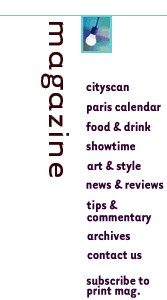Cresmaster cycle | Jackie Kennedy

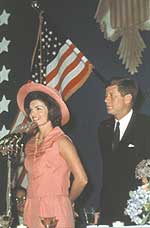 Rose silk ensemble, designed by Oleg Cassini, 1962
Rose silk ensemble, designed by Oleg Cassini, 1962
|
Jacqueline Kennedy and those sexy ’60s
by Carol Mongo

From floral-printed granny dresses (mid-’70s) and Space Age jumpsuits (1960s) to the gear reminiscent of the 1920s, ’30s ’40s and ’50s... you could say, I’ve worn it all! However, when I look back at my own wardrobe history, the most remarkable of these decades was beyond a shadow of doubt the 1960s.
And, this ten year stretch of time debuted with the stark simplicity and elegance of Jacqueline Bouvier Kennedy, America’s youngest First Lady, the living reflection of a calm, prosperous era. During her short stay in the White House when she shared her penchant for art with America, fashion trends followed suit and provided us with some of the most creative, forward-thinking clothing trends of the century.
This time of “Camelot,” as it was called, ended in flower power psychedelia, that in turn gave way to eclectic dress codes and musical trends that mirrored an increasingly volatile political climate, spurred by social reform. The ’60s were the decade that ignited my own passion for fashion and convinced me that I should be a part of it all, in some way. So, you can understand why both “Jacqueline Kennedy: The White House Years” and “Les Sixties: Mode d'Emploi,” currently on at the Musée de la Mode et du Textile — through March 16 — are so dear to my heart!
Entering the first section of the show, dedicated to Jackie Kennedy, you’re struck by the understated elegance this woman expressed via a very important garment: the ensemble she chose for her husband’s inauguration ceremony in January 1961. It’s a princess-line coat with oversized buttons, three-quarter length sleeves worn with long gloves, short, fur-trimmed boots and her “signature”: the pillbox hat.
The sheer magnitude of this woman’s extensive wardrobe is impressive. Altogether, 70 original garments and accessories in the possession of Jacqueline Kennedy from 1959 to 1963 are placed in the context of her role as First Lady by means of some 200 documents, including itineraries, speeches, state dinner menus, TV footage and countless photos on loan from the John F. Kennedy Library and Museum. Many of the clothes and shoes hardly appear to have been worn, yet with reference to her favorite labels — Givenchy, Chanel, Oleg Cassini (who in some cases copied Givenchy) and Bergdorf Goodman — this show speaks of Mrs. Kennedy’s exquisite sense of style.
The exhibition is organized in terms of “moments in the First Lady’s life.” There are garments she wore by day, evening clothes she donned at night, stunners for state dinners, and outfits for visits to India, Pakistan, Canada, France and the Vatican. Among the more historic items — the ivory satin “duchess” dress and stole she wore to the inaugural ball, the evening gown and its matching cape in pink and white raffia lace flaunted at the French presidential palace in the presence of General Charles de Gaulle in May 1961, and the embroidered pink chiffon number that caught the eye of Nikita Khrouchtchev the following month.
She stood for haute couture in its purest state: simple handmade garments that skimmed — never choked — the body and were enriched with hidden luxuries like: silk linings, hand-stitched hems and fabric covered buttons. I will admit that some of the silhouettes do seem a bit “chunky” and the hand-stitching — a sign of expensive clothes back then — appear somewhat “mammy made” to modern eyes accustomed to precision in this domain, more often than not enhanced by ultra-flat, refined wools and jerseys. Nevertheless, these looks represent the taste women in the public eye were expected to possess. They wore styles that inspired the rest of us to strive for elegance, when “pulling ourselves together.”
This exhibition also pays tribute to the cultural activities spearheaded by Jackie Kennedy during her three years in the White House. Right after the inauguration she had its interior totally renovated in an effort to return it to its former glory — as a national symbol. She was the initiator of numerous official events noted for their distinction and originality, transforming the presidential residence into a veritable “window for the arts,” where painters, musicians, writers and scientists mingled with politicians, diplomats and heads of state.
All of this energy was partially responsible for setting off a major movement in fashion which is spotlighted upstairs. As a matter of fact, Les Sixties, Mode d'Emploi (or “The ’60s — an instruction manual) provides such a smooth transition from the early to mid-’60s, that you may well thinkj some of the clothes are still those of Mrs. Kennedy. All in all — this was a great era for creativity, in general. It gave us — in no particular order: Carnaby Street, the Beatles and Motown... Andy Warhol, Peter Max and the Pop-Art/Op-Art movement... Roman Polanski and Jean-Luc Godard... Color television, the birth of ready-to-wear... And, Space Age fashion icons like Pierre Cardin, Paco Rabanne and Courrèges.
By the mid-1960s, the youth revolution was in full swing. This was an era of experimentation by Mary Quant — notably on the makeup front. Embodied by Twiggy’s blond waif-like crop and huge eyelashes, the ’60s look featured miniskirts, metal dresses, go-go boots and plexiglas jewelry. Geometrically cut shift-dresses were often more like “wearable works of art.” Color, patterns and bold prints were splashed over everything, and even Barbie doll dresses didn’t escape this revolution. Though it got a bit hair-raising toward the end of the ’60s — a time when America landed on the moon and its youth protested against the war in Vietnam — everyone enjoyed the excitement and innovations characteristic of the fashion, design, music and art of a decade that has never really been rivaled.
Musée de la Mode et du Textile, 109-111 rue de Rivoli, 1er, tel: 01 44 55 57 50/www.ucad.fr, Tue-Fri 11am to 6pm, Wed 11am to 9pm, Sat & Sun 10am to 6pm, 7E
|
|
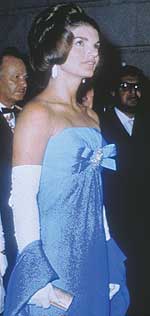
Oleg Cassini blue “crepe de soie” dress, 1962 |
|
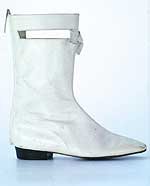
White boot by André Courrèges, 1965 |
|

Leather sandal by Roger Vivier, 1966 |
|

André Courrèges sunglasses as featured on the exhibition poster
© PETER KNAPP |
|
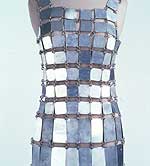
Paco Rabanne aluminium dress, 1969 |
|
|
